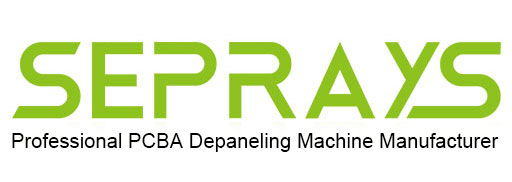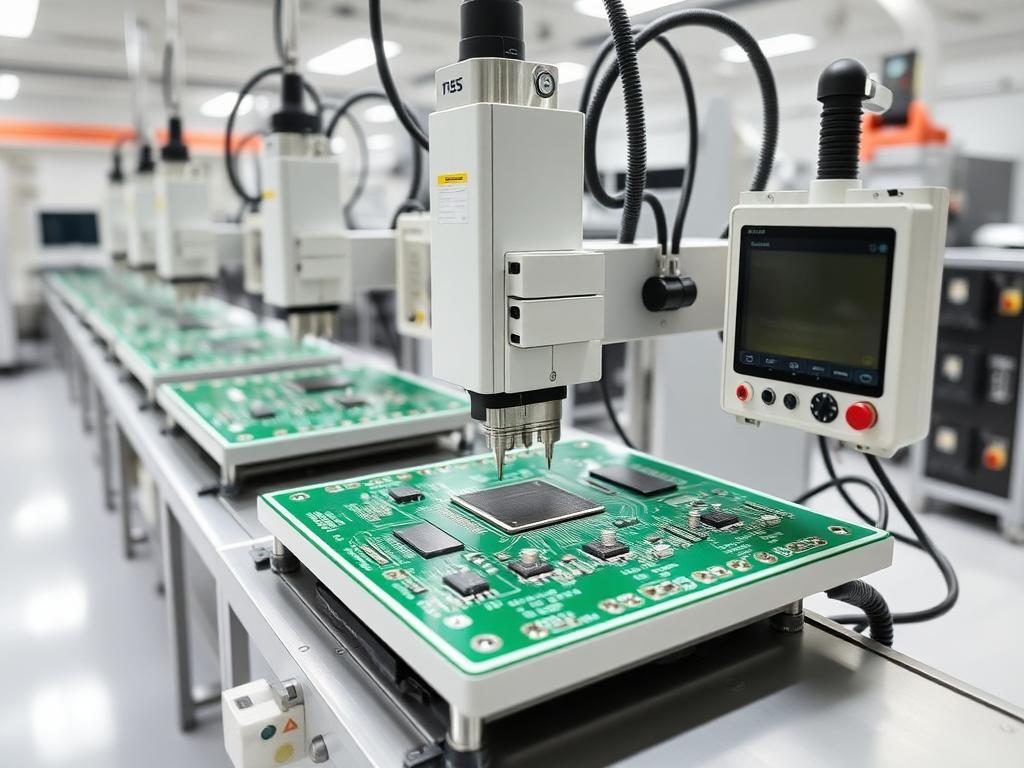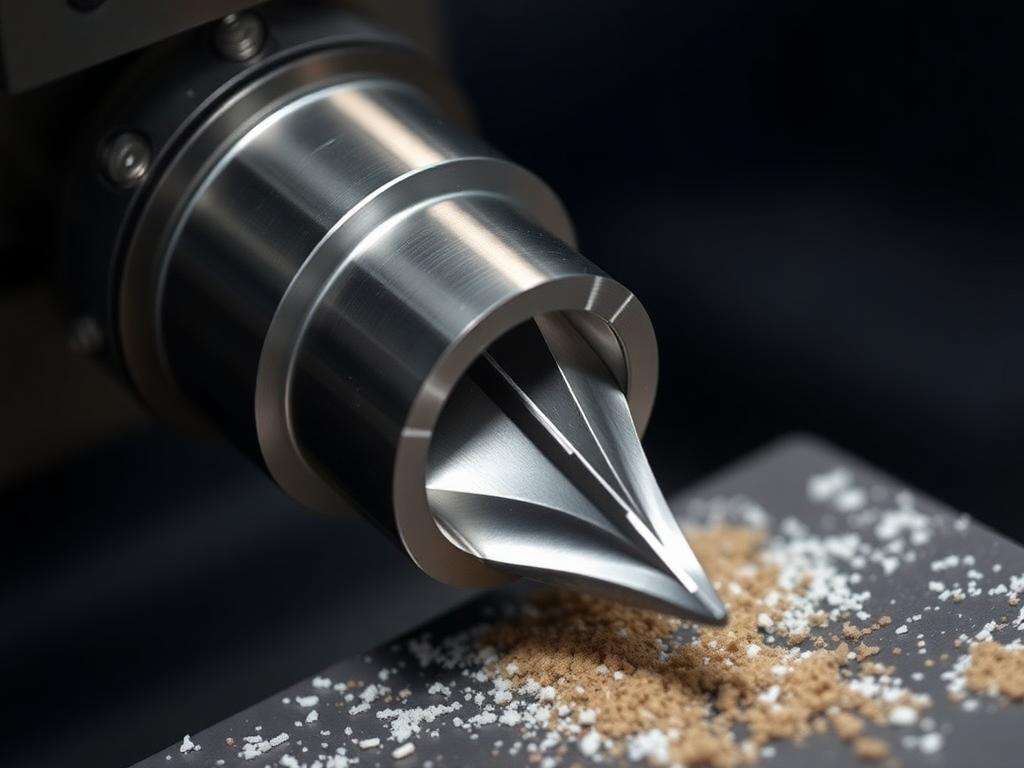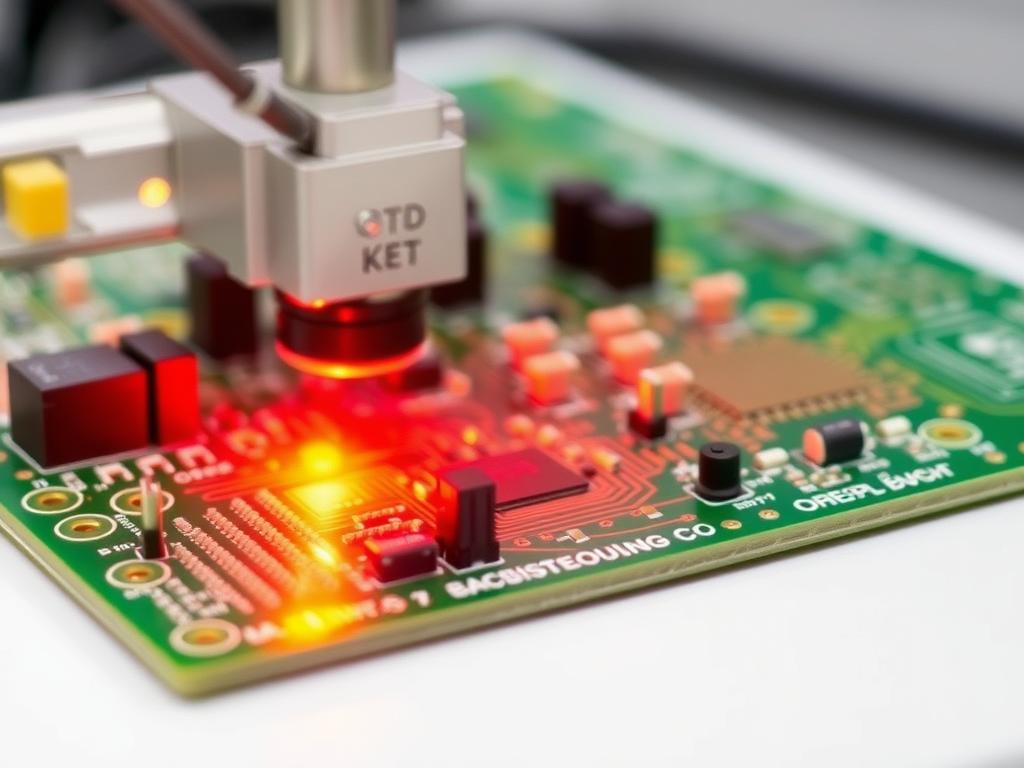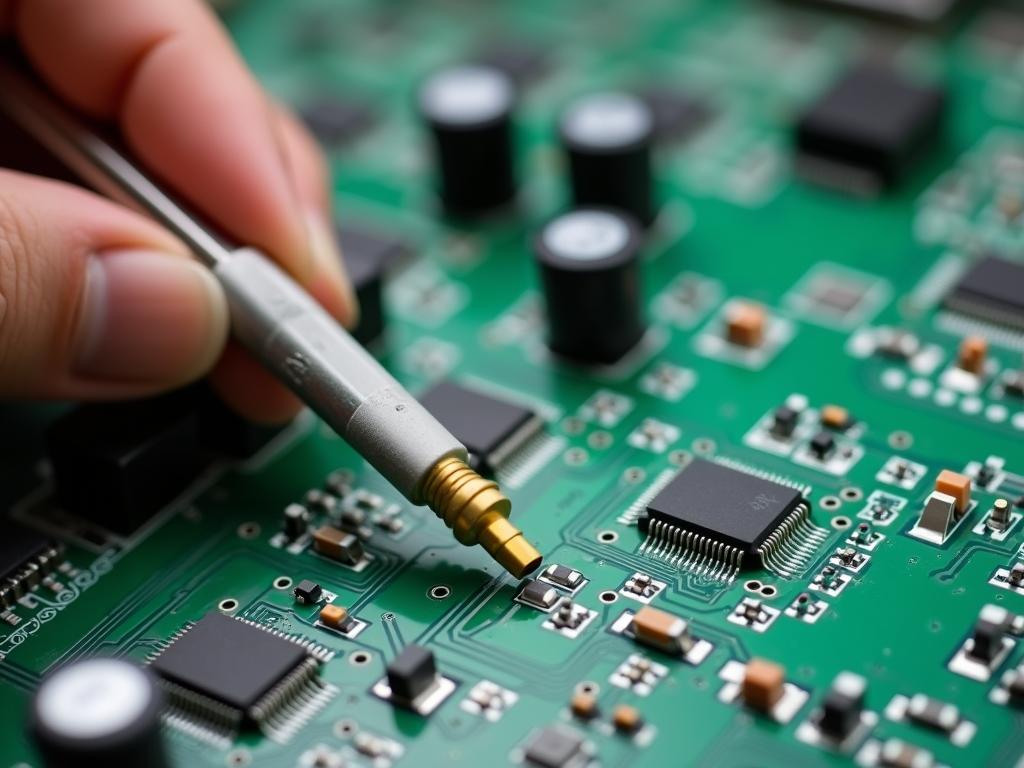![]()
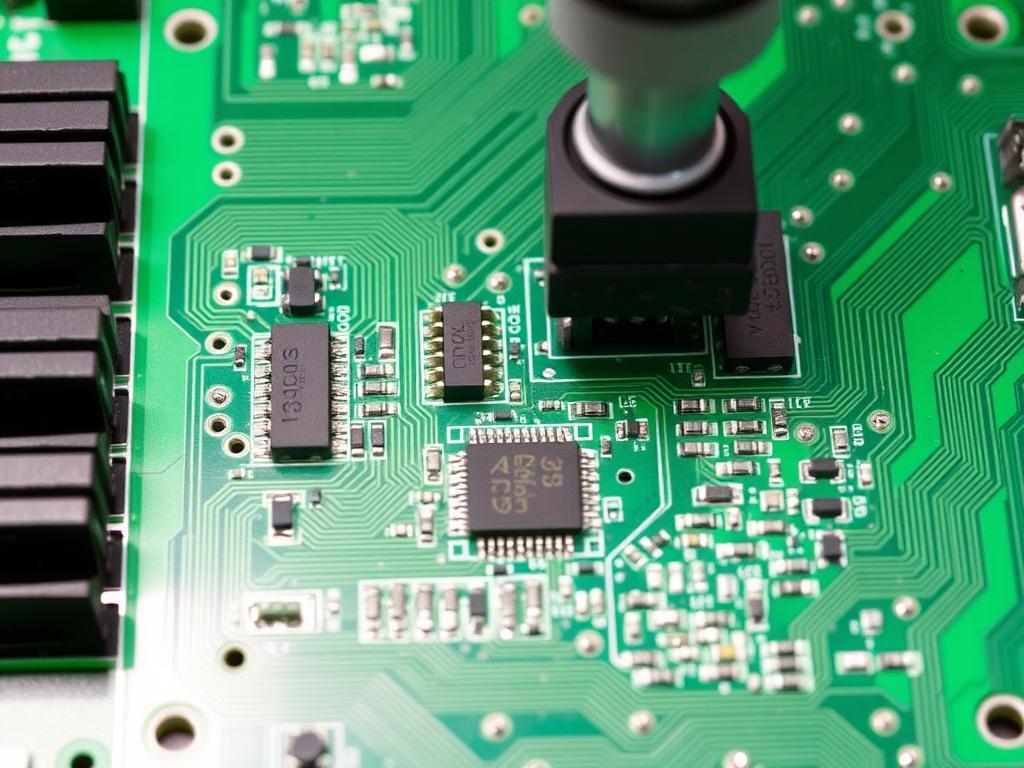
PCB depaneling for robotics
PCB Depaneling: From Manual Separation to Laser Precision – A 20-Year Journey
In the dynamic world of electronics manufacturing, the process of separating individual printed circuit boards (PCBs) from a larger panel, known as إزالة لوحة الدوائر المطبوعة, is critical. For two decades, I’ve been immersed in this process, witnessing its evolution from basic hand breaking to the sophisticated laser technology of today. This article explores the various methods of PCB depaneling, their advantages, disadvantages, and the future direction of this crucial manufacturing step. If you’re involved in electronics technology, large-scale PCB processing, or even as an individual PCB enthusiast, you’ll find valuable insights to enhance your understanding and potentially improve your processes.
1. What is ثنائي الفينيل متعدد الكلور Depaneling and Why is it Important?
Let’s start with the basics. In the تصنيع لوحات الدوائر المطبوعة process, multiple لوحات الدوائر المطبوعة are often fabricated on a single panel to maximize efficiency and reduce production costs. Once the components are mounted using تقنية التركيب السطحي و ال لحام joints are complete, these individual لوحات الدوائر need to be separated. This process of separating the لوحات الدوائر المطبوعة الفردية from the larger panel is known as إزالة لوحة الدوائر المطبوعة, also sometimes referred to as singulation. It is a pivotal step in the entire تجميع لوحة الدوائر المطبوعة line. Why is it so important? Because poorly executed depaneling can lead to damaged boards, compromised لحام joints, and ultimately, faulty electronic devices. The demand for لوحات الدوائر المطبوعة continues to rise, fueled by the internet of things (iot) and the ever-increasing number of electronic devices, making the عملية إزالة اللوحة not just a final step, but a critical link in the production chain.
For years, we have seen the pcb manufacturing industry rely on various طرق إزالة الألواح, from simple hand breaking to sophisticated جهاز التوجيه و أنظمة إزالة الألواح بالليزر. Each approach comes with its own set of benefits and challenges. Over my two decades in the industry, I’ve learned firsthand that the right method can significantly boost production line speed and reduce costs while ensuring the quality of the final product. Conversely, a poor choice can result in significant waste and delays.
2. What are the Different Depaneling Methods Used in تصنيع لوحات الدوائر المطبوعة?
Over the years, I’ve seen several طرق فصل لوحات الدوائر المطبوعة used, each with its own nuances and applications. It’s not a one-size-fits-all situation. The best method depends on the type of لوحة دارات مطبوعة, the complexity of the design, the materials used, and the volume of production. Here’s a breakdown of the most common طرق إزالة الألواح:
- Manual Depaneling: This is the simplest form, often done by hand using a specialized tool or even just bending and snapping along pre-scored lines. While it’s the most cost-effective option for very low volumes, it’s not suitable for large scale production due to the risk of إجهاد ميكانيكي and inconsistencies.
- إزالة الألواح على شكل V-Groove: This involves scoring the لوحة دارات مطبوعة panel along the separation lines with a V-shaped groove, allowing the boards to be easily snapped apart. It is a common method for simpler لوحات الدوائر and is faster than manual separation, but it still carries the risk of إجهاد ميكانيكي.
- Punch Depaneling: Here, a mechanical die with a shape matching the individual circuits is used to لكمة the boards تم ثقبها من اللوحة. This is suitable for high volume production of similar boards, but the tooling cost and inflexibility can be drawbacks.
- PCB Router Depaneling: أ جهاز التوجيه machine uses a high-speed rotating cutter to precisely cut the لوحات الدوائر المطبوعة from the panel. It is more versatile than punching or V-scoring, capable of handling complex shapes, curves, and sharp corners. It also creates less stress on the components.
- إزالة اللوحة بالليزر: This advanced method uses a precise القطع بالليزر beam to separate لوحات الدوائر المطبوعة from the panel. It is particularly suitable for very small لوحات الدوائر المطبوعة, complex shapes, and sensitive materials, as it minimizes part induced stress and provides a precise cut kerf width.
Each of these methods has found its place in the industry, and the choice depends heavily on the specific needs and volume of production. Over time I’ve seen a shift from manual and simple mechanical methods to more automated and precision-based techniques.
3. How Does the جهاز توجيه PCB Machine Work and Where is it Best Used?
ال موجه ثنائي الفينيل متعدد الكلور has become a workhorse in إزالة لوحة الدوائر المطبوعة. From my experience, I’ve seen it bridge the gap between simple V-scoring and the precision of إزالة الألواح بالليزر. So, how does it work? A pcb routing machine uses a high-speed rotating milling bit, guided by a computer-controlled process, to accurately separate لوحات الدوائر المطبوعة من أ لوحة أكبر. ال لوحة دارات مطبوعة panel is often held in place by a تركيبات, ensuring the التوجيه process is precise and consistent. This tool is used to create clean and accurate edges on the لوحات الدوائر.
A key advantage of a جهاز التوجيه is its versatility. Unlike لكمة depaneling, which requires a special fixture for each design, a جهاز التوجيه can handle a variety of shapes and sizes. The machine follows a programmed path, enabling it to cut curves and sharp corners with ease. This is particularly important when dealing with complex لوحة دارات مطبوعة designs that have intricate outlines. For rigid flex pcbs، أ جهاز التوجيه machine is also the best choice.
We’ve supplied many of our آلة توجيه ثنائي الفينيل متعدد الكلور to major electronics manufacturers like TP-LINK, Canon, BYD, Flex, TCL, Xiaomi, Lenovo, OPPO, HONOR, and Foxconn. They have found it to be reliable for a wide range of إزالة لوحة الدوائر المطبوعة needs, whether it’s لوحات الدوائر المطبوعة الفردية or multiple individual circuits. One of the core advantages of routing is that it minimizes stress on components during the متفرق process, unlike manual methods that can introduce significant إجهاد ميكانيكي.
4. What are the Advantages and Disadvantages of Mechanical PCB Routing?
As I’ve witnessed over the years, mechanical pcb routing offers a solid balance of versatility and efficiency, but it isn’t without its limitations. The advantage of speed and flexibility that التوجيه provides makes it a great fit for many production environments, but it’s important to understand the potential drawbacks. Here’s what I’ve learned:
المميزات:
- براعة: As mentioned before, التوجيه can handle various shapes, sizes, and materials. This makes it ideal for لوحات الدوائر المطبوعة with complex designs, curves and sharp corners, as well as boards with multiple individual circuits على لوحة أكبر.
- تقليل الإجهاد الميكانيكي: Unlike hand breaking, and v-cut methods, التوجيه minimizes the part induced stress على لوحات الدوائر المطبوعة, reducing the risk of damage to sensitive components, particularly those especially those close الى edge of the board.
- دقة: ال computer controlled process ل التوجيه ensures accuracy in cutting, resulting in cleaner edges. This is critical for subsequent assembly processes.
- Cost Effective: While the initial investment might be higher than simpler methods, the long-term operational costs of التوجيه are very reasonable and suitable for medium to large volumes.
- Suitable for Flex Circuit: Unlike mechanical dies or لكمة method, جهاز التوجيه machine is suitable for various type of material including ثني material.
Disadvantages:
- Tool Wear: The milling bits used for التوجيه wear out over time and require replacement. However, this can be mitigated by choosing suitable quality milling cutters like our قطع الطحن.
- Cutting Oils: The use of cutting oils can add additional steps to the process.
- Dust and Debris: التوجيه generates dust and debris, requiring proper ventilation and cleaning systems to maintain a clean working environment.
- Slower Than Punching: For very large volumes of identical لوحات الدوائر المطبوعة, لكمة depaneling might be a slightly faster method.
We have developed several routing machines, from the آلة إزالة الألواح السفلية من GAM 380AT PCB, to the آلة توجيه PCB الأوتوماتيكية GAM 330AT. These are designed to mitigate the drawbacks, focusing on efficiency and cleanliness. Over the past years, I’ve seen the technology behind these machines become more advanced, allowing the process to be much more precise and cost-effective.
5. How Does إزالة الألواح بالليزر Compare to Traditional Methods and is it Better?
إزالة الألواح بالليزر has emerged as a game-changer in the إزالة لوحة الدوائر المطبوعة world. As someone who has seen the industry shift manual to laser, I can say it offers unprecedented precision, speed, and flexibility, but it comes at a cost. Let’s discuss how إزالة الألواح بالليزر compares to more traditional methods.
Traditional methods like manual snapping, or قطع على شكل حرف V methods often rely on creating a weaker line that can be easily broken. While cost effective, they often introduce unwanted stress into the board. إزالة الألواح بالليزر, on the other hand, is a non-contact process. Instead of a mechanical force, a التوجيه بالليزر beam is used to precisely ablate the material along the separation line. This reduces the part induced stress and eliminates the risk of physical damage from tooling, making it perfect for very sensitive لوحات الدوائر المطبوعة أو ثني الركائز.
مزايا إزالة الألواح بالليزر:
- دقة عالية: إزالة الألواح بالليزر provides a very high degree of accuracy, with a cut kerf width ل less than 20 microns.
- الحد الأدنى من التوتر: The non-contact القطع بالليزر process significantly reduces إجهاد ميكانيكي, making it ideal for delicate لوحات الدوائر المطبوعة و ثني الدوائر.
- المرونة: إزالة الألواح بالليزر is capable of cutting complex shapes, المنحنيات والزوايا الحادة with extreme accuracy.
- Clean Cut: It produces very clean and smooth edges with no burrs or debris, reducing the risk of dust and contamination.
- Suitable for Small PCBs: When dealing with لوحات الدوائر المطبوعة الأصغر used in complex electronic devices, التوجيه بالليزر offers great precision where other methods might fail.
Disadvantages of Laser Depaneling:
- Higher Initial Cost: The equipment for إزالة الألواح بالليزر is significantly more expensive compared to traditional mechanical methods.
- Noticeable Heat Effect: Although minimal, there is some heat generated during إزالة الألواح بالليزر, which can have an effect on certain materials.
- Slower Than Some Methods: While fast, إزالة الألواح بالليزر can be slower than لكمة depaneling for very high volumes of identical boards.
Our experience shows that while the initial investment in إزالة الألواح بالليزر is higher, the benefits of reduced stress, increased accuracy, and overall quality often outweigh the cost, especially for high-value لوحات الدوائر المطبوعة ومعقدة دائرة مرنة designs. We’ve seen a growing adoption of إزالة الألواح بالليزر in the industry. Our آلة القطع بالليزر DirectLaser H5 PCB-FPC و جهاز الليزر DirectLaser H3 عبر الإنترنت are testaments to the effectiveness and advancement of the technology.
6. When is لكمة Depaneling the Right Choice for ثنائي الفينيل متعدد الكلور?
لكمة depaneling, while not as versatile as جهاز التوجيه أو إزالة الألواح بالليزر, still holds its ground as a valuable method in specific scenarios. In my two decades in this industry, I’ve seen its strength in high-volume production of identical لوحات الدوائر المطبوعة where the design is relatively simple and well-defined.
عملية لكمة depaneling involves using a mechanical die, customized to the specific shape of the individual circuits. This die is pressed onto the لوحة دارات مطبوعة panel, and the boards are broken out of the panel. It is a fast and relatively efficient method for high production quantities.
Advantages of Punch Depaneling:
- سرعة عالية: For large volumes of identical لوحات الدوائر المطبوعة, لكمة depaneling can be significantly faster than routing or laser. The advantage of speed makes it an attractive option for high-volume manufacturers.
- Lower Operational Cost: Once the tooling is created, the operational cost per board is lower.
- Consistent Results: The process is very repeatable, ensuring consistent results across all the boards on the panel.
Disadvantages of Punch Depaneling:
- High Tooling Cost: The initial tooling cost is high, as you need to manufacture a custom die for each لوحة دارات مطبوعة design. This can be prohibitive for smaller production runs.
- Lack of Flexibility: Unlike routing, punch depaneling is not suitable for complex shapes, curves or sharp corners. Each لوحة دارات مطبوعة design requires a different die.
- Mechanical Stress: It can also introduce more إجهاد ميكانيكي on the components compared to جهاز التوجيه أو إزالة الألواح بالليزر, which can damage sensitive parts, particularly if they are near the separation line.
- Not suitable for flex: لكمة depaneling is not suitable for ثني material.
In our experience, we’ve seen لكمة depaneling favored by manufacturers producing large quantities of identical, simpler boards, where tooling cost is amortized over a high production volume. For instance, in the production of basic electronics like consumer gadgets. However, its inflexibility and limitations make it less suitable for complex لوحات الدوائر and prototypes, and it definitely doesn’t come anywhere near the precision of إزالة الألواح بالليزر. ملكنا ماكينة تقطيع وتثقيب PCB وFPC ZM10T و15T are examples of our commitment to this method, offering robust and reliable performance.
7. What is V-Cut Depaneling and How Does it Impact Manufacturing?
V-cut depaneling is another method I’ve seen frequently used in the industry. It’s a process that involves creating a V-shaped groove (النتيجة-v) on the top and bottom surfaces of the لوحة دارات مطبوعة panel along the intended separation line, allowing the boards to be snapped apart relatively easily. In essence, it pre-weakens the material so that the لوحات الدوائر المطبوعة الفردية can be broken out of the panel with minimal force.
في قطع على شكل حرف V depaneling, the panel are scored using a specialized tool. The depth of the النتيجة-v needs to be carefully controlled, ensuring that it’s deep enough to facilitate easy separation but not so deep that it weakens the الركيزة too much. The method relies on manual or machine-assisted separation after the النتيجة-v is complete.
Advantages of V-Cut Depaneling:
- فعالة من حيث التكلفة: It’s a relatively inexpensive method, particularly for high volumes of simple designs.
- Fast and Efficient: عملية panel are scored is quick and efficient, making it suitable for large scale production.
- Simple Process: It doesn’t require complex machinery or specialized skills.
Disadvantages of V-Cut Depaneling:
- Mechanical Stress: The snapping process can induce إجهاد ميكانيكي, particularly on لحام joints and components that are close to the separation line. This can lead to board damage and failures.
- Limited Design Flexibility: It is not suitable for لوحات الدوائر المطبوعة with complex shapes, المنحنيات والزوايا الحادة, or those that require a precise separation path. It works best for straight line separation.
- Less Precise than other methods: The breaking step can create an uneven and rough board edges.
- Not Suitable for Flexible Materials: When it comes to flexible materials such as ثني, v-scoring isn’t the best solution. The ثني material can get damaged when broken out of the panel, and it doesn’t guarantee a clean متفرق خط.
We understand the trade-offs involved with قطع على شكل حرف V depaneling, and our range of إزالة الألواح على شكل V-Groove الآلات، مثل ZM30-ASV لوحة PCB أوتوماتيكية بالكامل من النوع V-groove و ZM30-P PCB المقصلة فاصل, aim to maximize the benefits of this method while mitigating its inherent limitations. While this method is commonly used in the industry, it’s important to carefully consider its drawbacks, particularly when dealing with higher value or complex لوحات الدوائر.
8. Why is Precision and Minimal الإجهاد الميكانيكي so Crucial in Circuit Board إزالة اللوحة؟
Precision and minimal إجهاد ميكانيكي are non-negotiable requirements in modern لوحة الدائرة depaneling. Over the years, I’ve seen firsthand the repercussions of poor separation techniques. The impact on the quality and reliability of the final product is enormous, which is why we have strived to develop solutions that minimize both.
Why is this so crucial? First, لوحات الدوائر are packed with delicate components and intricate traces. These components, especially those using تقنية التركيب السطحي, are extremely sensitive to physical forces. Applying too much إجهاد ميكانيكي خلال عملية إزالة اللوحة can cause cracks in the لحام المفاصل, component damage, or even delamination of the board itself. These damages are not always immediately apparent but can lead to premature failure in the field.
Second, modern electronics have become incredibly complex, often involving multiple layers and intricate الدائرة layouts. Any deviations from the intended separation path can sever traces or other delicate features, rendering the board unusable. This is especially true when dealing with لوحات الدوائر المطبوعة الأصغر and tight spaces. This is where precise القطع بالليزر shines.
Finally, quality and reliability are crucial factors in the competitiveness of products, especially in high-stakes sectors like aerospace, medical devices, and automotive. The cost of failure is far higher than the cost of investment in good equipment.
Achieving precision and minimal stress requires using the right أنظمة إزالة الألواح, whether that’s a carefully programmed router cutting machine or a التوجيه بالليزر system. Proper تركيبات, precise alignment, and controlled forces are also crucial to maintaining the integrity of every board. For us, it’s not just about فصل الفرد boards, it’s about ensuring that each board is ready to perform its intended function reliably for a long time. Our commitment to precision is evident in every one of our products, from our automated solutions to our precision cutting tools.
9. How Can Automation Improve the Depaneling Process و Increase Production Line Speed?
Automation has dramatically transformed the إزالة لوحة الدوائر المطبوعة landscape, and for the better. In the past, much of the process was done manually, which was slow, inconsistent, and prone to errors. In today’s عملية التصنيع world, automation plays a key role in ensuring a high level of production line output and reducing waste.
Automation brings many advantages to the عملية إزالة اللوحة. First and foremost, it increases speed. Automated machines can process many boards per hour compared to manual operations. The increase in production line speed directly translates into reduced production times and lower operational costs. Also, automation ensures consistency, a critical factor in high volume production, especially when working with لوحات الدوائر that require high precision.
Moreover, automated systems reduce the need for manual labor, minimizing the risk of human error and workplace injuries. When coupled with vision systems and advanced software, automated depaneling machines can detect and rectify any misalignment or issues immediately, guaranteeing that each board is separated correctly. This is something we, at pcbdepaneling.com, focus on a lot.
We have developed a variety of automated solutions, including Automatic Plate Palletizing Machines و Automatic Sorting and Palletizing Machines, designed to work seamlessly within your systems that increase production line. These machines integrate smoothly with existing production lines and reduce the need for manual intervention. The use of automation not only improves the عملية إزالة اللوحة but also increases the efficiency and profitability of the entire production line. Our experience shows that investing in automated systems is a step towards increased efficiency, reduced waste, and improved product quality.
10. How Do I Choose the Best نظام التفكيك for My ثنائي الفينيل متعدد الكلور?
اختيار الصحيح نظام فصل الألواح من اجلك لوحات الدوائر المطبوعة can make all the difference in the efficiency, quality, and cost-effectiveness of your production. The best system is dependent on several factors, and there’s no “one-size-fits-all” solution, it’s very important to assess all relevant factors. Here are some factors that should play a role in your decision.
- حجم الإنتاج: If you are processing a high volume of identical boards, a لكمة depaneling system might be suitable, if design constraints allow for it. If you produce small quantities of boards with complex shapes and المنحنيات والزوايا الحادة, then a جهاز التوجيه أو إزالة الألواح بالليزر system might be a better choice.
- PCB Design Complexity: Complex designs with tight components require a precise and low-stress method, making إزالة الألواح بالليزر or precision التوجيه your preferred option. Simple designs with straight separation lines are fine with a v-cut or لكمة method.
- Material Sensitivity: If you have sensitive components that are close to the separation line, إزالة الألواح بالليزر should be considered due to its minimal إجهاد ميكانيكي. ثني materials will also need a more careful approach, and جهاز التوجيه أو إزالة الألواح بالليزر are the best choice in that case.
- ميزانية: The initial cost of إزالة الألواح بالليزر is high, so if you are operating within a limited budget, then a جهاز التوجيه machine would be a better choice, as it provides an excellent balance between accuracy and cost.
- Required Line Speed: If your production line needs to be really fast, a لكمة method is still valid for certain types of circuit boards, but is not as flexible as جهاز التوجيه أو الليزر الأنظمة.
- Long Term Costs: Consider not only the initial cost but also the operational costs, including tool replacement, energy consumption, and waste disposal. While إزالة الألواح بالليزر has a higher initial cost, it might provide long term cost benefits due to it’s precision, low stress, and clean cuts.
For a lot of our clients, the role in the manufacturing process of depaneling machines is critical. When choosing your أنظمة إزالة الألواح, you should always look for a reliable supplier that can provide not only top quality machines, but also technical support and parts when you need them. We have the necessary experience to help you choose the right system.
الأسئلة الشائعة
What is the difference between PCB depaneling and PCB singulation?
There is virtually no difference between PCB depaneling and singulation. Both terms refer to the عملية الفصل فردي لوحات الدوائر المطبوعة من لوحة أكبر.
Can I depanel PCBs with components on them?
نعم، إزالة لوحة الدوائر المطبوعة is usually done after the components are mounted, but it should always be done with appropriate care to avoid damage to the components or لحام المفاصل.
What method should I use for my flex PCBs?
ل flex pcb depaneling plays a pivotal role. Given the sensitive nature of flexible materials, the best options for ثني circuits are either جهاز التوجيه أو إزالة الألواح بالليزر. Both of these methods provide the necessary precision and low stress needed to prevent material damage.
Is Laser depaneling really worth the high cost?
It really depends on your specific situation. While the initial investment is higher, the benefits of precision, minimal stress, and the ability to handle complex designs may offset the higher cost, especially for high-value boards.
What kind of maintenance do PCB depaneling machines require?
The maintenance requirements vary. A جهاز التوجيه machine will require regular bit replacement and cleaning. إزالة الألواح بالليزر machines will require cleaning of the القطع بالليزر head and optical components. All machines will require regular maintenance, which can be done by qualified technicians.
النقاط الرئيسية
- إزالة لوحة PCB هي عملية فصل الأفراد لوحات الدوائر المطبوعة from a larger panel, essential in تجميع لوحة الدوائر المطبوعة.
- Several methods exist, including manual separation, قطع على شكل حرف V, لكمة, جهاز التوجيه، و إزالة الألواح بالليزر.
- جهاز التوجيه machines are versatile, suitable for complex shapes, and minimize part induced stress, but they require regular maintenance.
- إزالة الألواح بالليزر provides high precision and minimal stress, ideal for small, delicate لوحات الدوائر المطبوعة و ثني materials, though with a higher initial investment.
- لكمة depaneling is ideal for high-volume production of identical, simple boards, but is inflexible and has high tooling costs.
- V-cut depaneling is cost effective for straight lines, but may introduce إجهاد ميكانيكي ل لحام المفاصل.
- Automation enhances speed, consistency, and reduces errors in the عملية إزالة اللوحة.
- Choosing the correct نظام فصل الألواح depends on your production volume, design complexity, budget, and desired quality.
As a veteran in the industry, I’ve dedicated my career to understanding and improving the عملية إزالة اللوحة. My goal is to provide solutions that are both innovative and practical, helping you achieve your manufacturing goals. If you’re looking to improve your own process, we invite you to explore our range of products on our website, or contact us for more detailed assistance. You can learn more about our آلة توجيه ثنائي الفينيل متعدد الكلور, explore our إزالة الألواح على شكل V-Groove, check out our آلة التثقيب PCB/FPC, discover our المعدات الأوتوماتيكية, find the perfect مُكَمِّلات, and explore our معدات خط كامل SMT as well as إزالة الألواح بالليزر ثنائي الفينيل متعدد الكلور الحلول.
